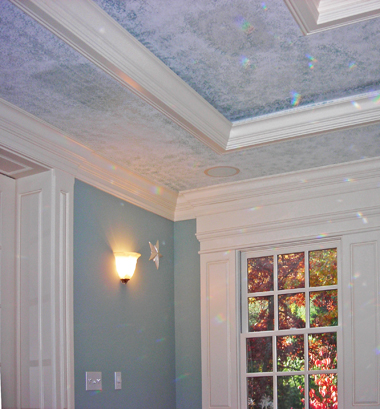The psychology of color and its effects on people has real merit. In fact, marketers invest heavily in color psychology as a way of making their advertising more effective. Hospitals use color, too, to help promote healing. Since there is real validity to the premise that certain colors promote certain feelings and moods, what better way is there to decide upon interior paint colors for your home than with color psychology?

You may not want to choose a paint color that makes people hungry, as some advertisers do. But, if you’re trying to sustain a healthy weight, you may want to choose shades which suppress the appetite. Researchers have found that blue works as an appetite suppressant. Blue is also associated with:
• Stress reduction
• Evoking a sense of calm
• Enhancement of artistic and verbal expression
• Relief from high blood pressure, throat problems, and insomnia
• Strength
• Dependability
The eye can see millions of colors. When choosing an interior paint color, you may want to avoid one that is known to increase blood pressure, which is what red does. If blood pressure isn’t a problem, there are other attributes of red which may make it a desirable shade for some of your interior walls. Red is associated with:
• Romance
• Excitement
• Energy
• Intensity
• (Too much red could promote aggressiveness or anger)

The view of a colorful nature scene has been found by researchers to promote recovery from surgery. For that reason, greens are currently popular colors in the design of health care facilities. There are other reasons green could be an ideal room color. Green is also associated with:
• Forgiveness
• Compassion
• Tranquility
• Fertility
• Growth
Yellow, in some circles, is believed to promote fear, hunger, and lack of determination; and too much yellow can lead to hyperactivity. But yellow is also associated with sunshine, which conveys joy. Additional positive attributes associated with yellow include:
• Being uplifted
• Promoting intellect
• Laughter
• Cheeriness
• Optimism
• Warmth

It has been said, as regards interior design, that gray is the new beige. Gray is an ideal background color because of its neutrality. Some additional attributes associated with gray include:
• Timelessness
• Practicality
• Knowledge
• Intellect
• Dignity
• Authority
• Sleekness or refinement
Would you like to use a paint color for your interior which encourages optimism, socializing, and joy?
If so, orange may be your perfect color choice, though, in some circles, orange is also thought to inspire confusion, weariness, and pessimism. There are more positive than negative things to say about orange, though. Other desirable attributes associated with orange include:
• Feeling energetic
• Happiness
• Enthusiasm
• Sophistication
• Warmth
• Prosperity
• Stimulation
• Change

White also inspires certain moods and feelings. Author G. K. Chesterton said, “White…is not a mere absence of color; it is a shining and affirmative thing, as fierce as red, as definite as black…” Some would describe white as sterile or boring. But white evokes many positive attributes, such as:
• Innocence
• Cleanliness
• Purity
• Neutrality
• A sense of having more space
Information is readily available about the psychology of other colors besides the above-named. With such a vast selection of paint colors, it’s helpful to narrow down your color choice based on emotions evoked by the various shades. For help choosing the right shade of the interior paint color you’re looking for, contact our professionals.
Franklin Painting LLC – Call us Toll Free at 877-646-7774
or at our main office number 860-678-7701
2 Eastview Drive, Farmington, CT 06032
Exterior House Painting in CT towns like farmington, ct 06032 – avon, ct 06001 – simsbury, ct 06070 – west simsbury, ct 06092 – canton, ct 06019 – burlington, ct 06013 – bloomfield, ct 06002 – unionville, ct 06085 – weatogue, ct 06089 – suffield, ct 06078 – windsor, ct 06095 – granby, ct 06035 – collinsville, ct 06022 – west hartford, ct 06110 – 06117 – 06119 – 06127 – 06133 – 06137 / bristol, ct 06010 – new britain, ct – 06050 – 06051 – 06052 – 06053 / newington, ct 06111 – wethersfield, ct 06109 – cromwell, ct 06416 – rocky hill, ct 06067- berlin, ct 06037 – kensington, ct 06037 – portland, ct 06480 – middletown, ct 06547 – meriden, ct 06450 – middlefield, ct 06455 – east hampton, ct 06424 – chesire, ct 06410 – southington, ct 06489 – glastonbury, ct 06033 – south glastonbury, ct 06073- south windsor, ct 06074 – elllington, ct – east windsor, ct 06088 – hebron, ct 06248 – marlborough, ct 06447 – manchester, ct 06040 – 06042 – 06045 – bolton, ct 06043 – colchester, ct 06415 – tolland, ct 06084 and more!

Frank Campanelli, the esteemed founder of Franklin Painting LLC, has been leading the company since 1986. He takes immense pride in the stellar reputation his dedicated team has built by consistently delivering top-notch service to each customer.



